Researchers are perceived as more in agreement when it comes to their views on how the corona pandemic is being handled in Sweden. The tone of news reporting on the coronavirus is perceived as more alarmist than in February. These are some of the latest findings of a study being conducted by the non-profit organisation VA (Public & Science) to investigate communication about the coronavirus in Sweden.

In collaboration with researchers from the Karolinska Institute and Södertörn University, VA (Public & Science) is conducting a study of how people are receiving and interpreting information about the coronavirus and the ongoing pandemic. Here are the findings from the 15th wave of the survey, carried out between 17–23 March 2021.
Researchers are perceived to be more in agreement when it comes to how the corona pandemic is being handled in Sweden compared to in February. In March, seven out of ten Swedes (69 percent) perceive researchers to be fairly or very in agreement, which is an increase of seven percentage points since last month. The research community is perceived to be less in agreement among people who earn 42,000 SEK or more per month. Among those with higher salaries, 61 percent perceive researchers to be in agreement, compared with 74 percent of those who earn less than 25,000 SEK per month.
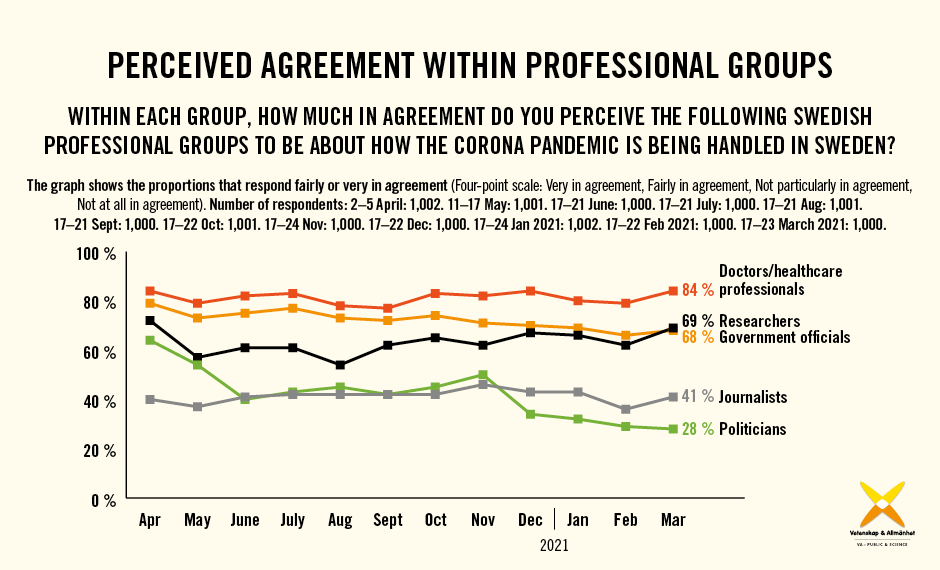
Confidence in various professional groups that comment on the coronavirus in the media has remained unchanged since February. In March, nine out of ten (90 percent) of Swedes have fairly or very high confidence in doctors and other healthcare professionals. Almost as many (86 percent) have the same levels of confidence in researchers. Just over half (56 percent) of Swedes have high confidence in government officials and less than one in four (22 percent) have high confidence in politicians as well as journalists. Supporters of the Sweden Democrats have less confidence in all professional groups compared to those who support other political parties. There is a particularly large difference in how government officials are perceived; 18 percent of Sweden Democrat supporters have high confidence in this group, compared with 56 percent among the general population. Among supporters of the Social Democrats, the corresponding proportion is 80 percent.
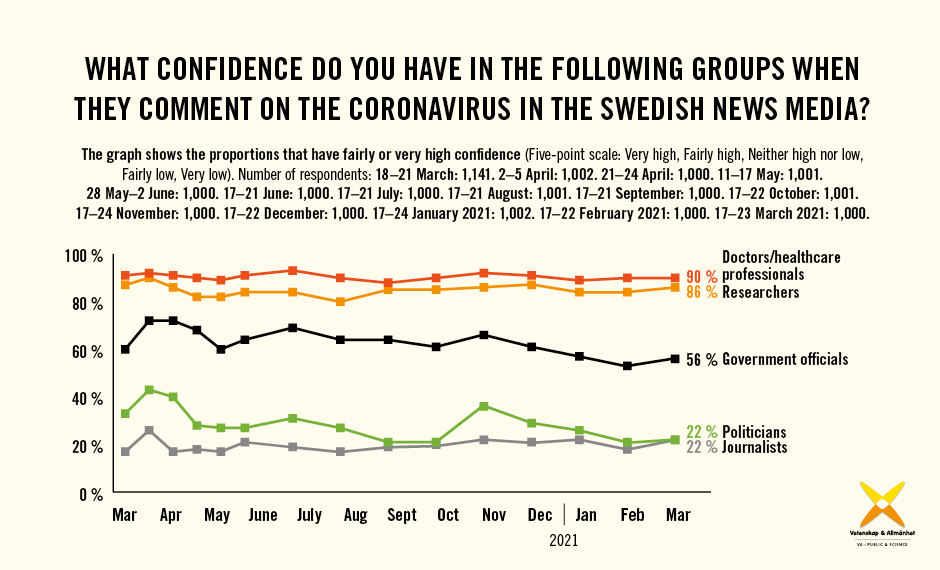
The tone of reporting on the coronavirus is perceived to be more alarmist than it was in January and February. In March, just over half (53 percent) perceive the tone of the reporting to be fairly or very hyped/alarmist, compared with 46 percent in February. On the other hand, one in ten (9 percent) perceive the reporting as fairly or very cautious/watchful, while 35 percent consider that it is neither hyped/alarmist nor cautious/watchful. Those with a higher income are more likely to perceive the tone as alarmist. Among people with a monthly income of 42,000 SEK or higher, 61 percent perceive the tone of news reporting as fairly or very hyped/alarmist. The corresponding proportion among people with a monthly income below 25,000 SEK is 49 percent.
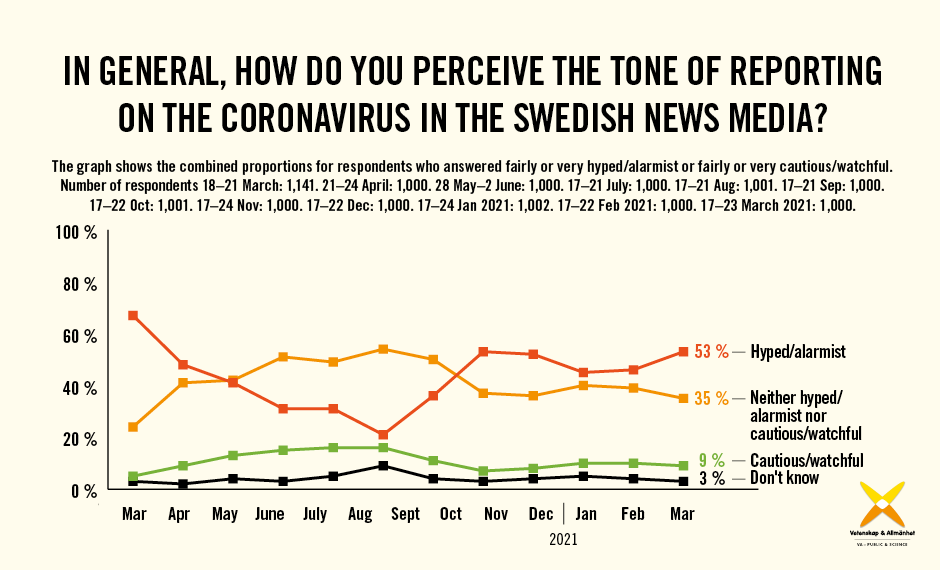
News consumption about the coronavirus has not changed since February. Swedish Television (SVT) is still the channel that most Swedes (67 percent) have got information from, followed by TV4 (41 percent), the tabloid Aftonbladet and Swedish Radio (both at 38 percent).
However, news habits vary among different parts of the population. People aged 65 years or older consume news media to a greater extent than those aged between 18 and 29 years old. For example, 85 percent of senior citizens consume SVT, while the corresponding proportion is 49 percent among younger people. This pattern can also be seen for local morning newspapers (which 58 percent of senior citizens and 20 percent of younger people consume), Swedish Radio (51 percent among senior citizens and 26 percent among younger people) and TV4 (50 percent among senior citizens and 20 percent among younger people). Those with a monthly income higher than 42,000 SEK consume more news about the coronavirus from Dagens Nyheter, Svenska Dagbladet, foreign/international media and other news media compared with people with lower incomes.
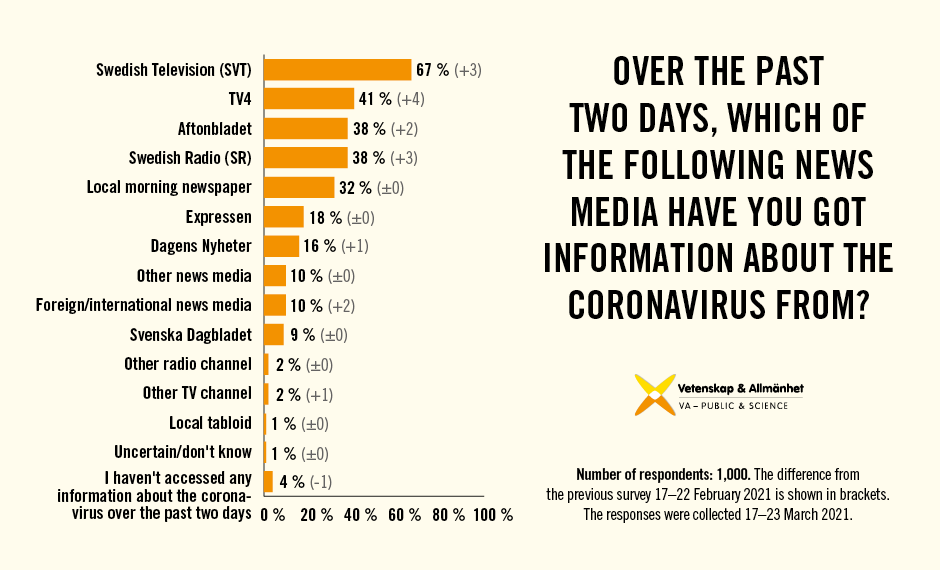
Confidence in the media’s reporting on the coronavirus has not changed since February. As previously, it is the public service channels that enjoy the highest confidence. In March, eight out of ten Swedes (78 percent) have fairly or very high confidence in the news reporting of Swedish Television (SVT), with the corresponding proportion for Swedish Radio at 74 percent. This is followed by TV4 (54 percent), Dagens Nyheter (49 percent) and Svenska Dagbladet (43 percent). Smaller proportions of the population have high confidence in the reporting of Expressen (17 percent), Aftonbladet (21 percent) and foreign/international media (23 percent). On the other hand, a relatively large proportion of Swedes have fairly or very low confidence in the evening newspapers (32 percent for both Aftonbladet and Expressen). However, the corresponding proportion for international media is only 7 percent. This low level of confidence is explained by the fact that many respondents are uncertain/don’t know (36 percent).
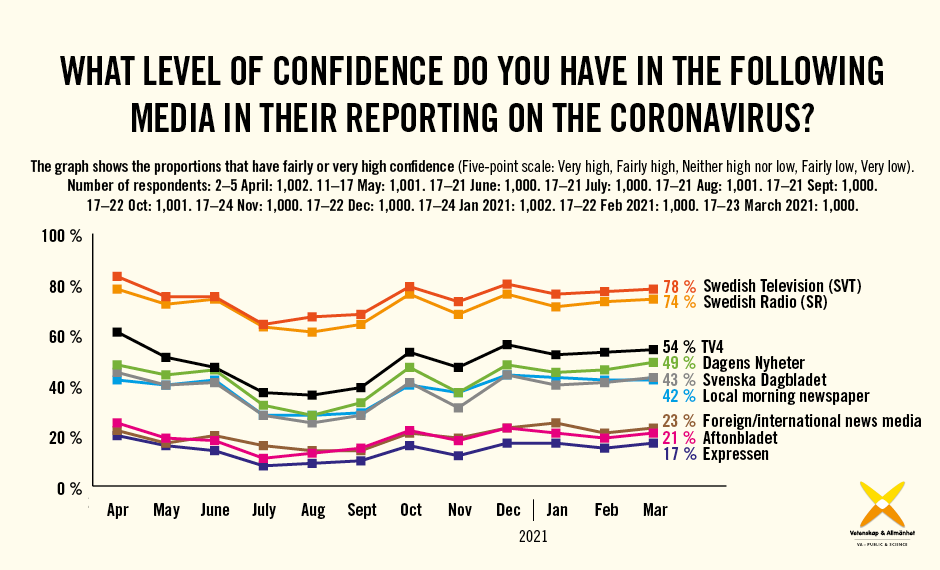
About the survey
The survey was conducted by Kantar Sifo and consisted of 1,000 interviews with a web panel based on random sampling. The interviews were conducted 17–23 March 2021. The results are weighted based on gender, age and region of residence.
In order to monitor the Swedish public’s news consumption, confidence in key professional groups and attitudes towards media reporting over time, we are conducting a number of studies during the course of the pandemic. We also plan to undertake a content analysis of reporting on the coronavirus in the Swedish media in order to map any changes in reporting during different phases, and how this relates to public attitudes during the same time period.
The study is being conducted with the support of, Södertörn University,the Swedish Research Council and the Wenner-Gren Foundations.
Read more about VA’s study and the results of the first, second, third, fourth, fifth, sixth, seventh, eighth, ninth, tenth, eleventh, twelfth, thirteenth and fourteenth waves of the study.

